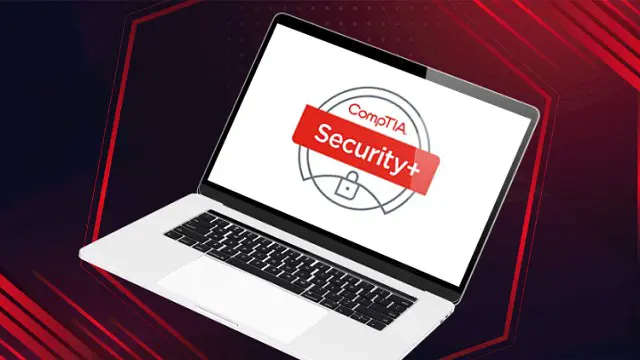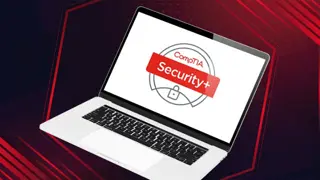- Reed courses certificate of completion - Free

CompTIA Security+(SY0-601) Complete Course | comptia
Dive into comptia security. Learn CompTIA Security plus topics and sample questions for the Comptia security+ SY601 exam
Oak Academy
Summary
Overview
Let's dive into comptia security. Learn CompTIA Security + topics and sample questions for the comptia security+ SY601 exam.
Everything you need to pass the CompTIA Security+(SY0-601) is here.
Hello there,
Welcome to the “CompTIA Security+(SY0-601) Complete Course | comptia 2021” course.
Every internet-connected person is affected by issues pertaining to cybersecurity. As a result, cybersecurity professionals are increasingly in-demand.
This course walks you through all the things you need to pass the CompTIA Security + (SY601) exam, step by step.
You can pass the CompTIA Security + exam by studying the topics covered throughout the course.
By the way, you don't need to know anything about CompTIA security +.
We will tell you all the things you need to pass the comtia security plus (SY601) exam.
Our course consists of 11 basic parts.
However, in order to better understand the topics, these basic topics are divided into parts and explained in 44 small chapters in CompTIA Security+(SYo-601).
Each of the sections is important on its own. It also relates to other departments.
As you follow the course, you will hear the same terms in different lessons. This is because many terms in the field of Security can be used in relation to each other in different subjects.
For example, the subject of encryption is mentioned in many places.
Although the basic meaning is the same, usage types can gain different meanings on different platforms.
The narration of the topics is brief and for the exam.
If you wish, you can improve yourself by using the topics covered in the lessons.
Because at the end of the course, you will see all the topics used in the field of Security.
All you have to do is search the subject on the internet and continue learning in comptia security.
During the course, sample questions were given at the end of each section in comptia.
These questions are generally similar to questions that were previously found in the CompTIA Security + exam.
There is no such thing as the same question will always appear in the exam in CompTIA.
However, the questions to be asked on a certain subject are also close to each other in comtia.
This course is for Comptia Security + (SY0-601).
CompTIA updates its exams every 3 years.
SY0-601 exam has been updated in 2020.
CompTIA Security+(SYO-601)
Basically in CompTIA Security + (SY0-601) exam;
1. Attacks, Threats, and Vulnerabilities
2. Architecture and Design
3. Implementation
4. Operations and Incident Response
5. Governance, Risk, and Compliance
Questions are asked from the fields. Throughout the course, topics related to these areas are explained.
In this course you will learn;
Passing the CompTIA Security+ certification exam with confidence
Understand computer security, its functions, and its components
Performing basic security configurations
Become an effective security technician in a business environment
Network topologies
Threat analysis
No prior knowledge is needed!
Why would you want to take this course?
Our answer is simple: The quality of teaching.
OAK Academy based in London is an online education company. OAK Academy gives education in the field of IT, Software, Design, development in English, Portuguese, Spanish, Turkish and a lot of different language on Udemy platform where it has over 1000 hours of video education lessons. OAK Academy both increase its education series number by publishing new courses, and it makes students aware of all the innovations of already published courses by upgrading.
When you enroll, you will feel the OAK Academy`s seasoned developers expertise. Questions sent by students to our instructors are answered by our instructors within 48 hours at the latest.
Video and Audio Production Quality
All our videos are created/produced as high-quality video and audio to provide you the best learning experience.
You will be,
Seeing clearly
Hearing clearly
Moving through the course without distractions
You'll also get:
Lifetime Access to The Course
Fast & Friendly Support in the Q&A section
Dive in now “CompTIA Security+(SY0-601) Complete Course | comptia 2021”.
We offer full support, answering any questions.
See you in the course!
Certificates
Reed courses certificate of completion
Digital certificate - Included
Will be downloadable when all lectures have been completed
Curriculum
-
Introduction to CompTIA Security + 11:58
-
Basic Security Concepts 38:10
-
Identity Management 51:55
-
Summary-1 in CompTIA Security + 03:26
-
Users in CompTIA 46:31
-
Comparing Access Control Models 26:49
-
Virtualization 20:32
-
Network Technologies 1:34:45
-
Wireless Networks 22:31
-
Summary-2 03:03
-
Network Security Technologies 28:12
-
Intrusion Detection Systems 24:17
-
Virtual Private Network(VPN) Technologies 15:48
-
Security Threats 42:21
-
Securing Wireless Networks 06:21
-
Understanding Wireless Attacks 24:20
-
Summary-3 02:44
-
Network Attacks 27:07
-
Password Attacks 28:49
-
Zero-Day Attacks 07:19
-
Code Attacks 23:30
-
Web Server Attacks 20:25
-
Social Engineering Attacks 42:14
-
Summary-4 03:32
-
Memory Buffer Vulnerabilities 29:06
-
Preventing Attacks 23:26
-
Server Security 1:03:35
-
Mobile Devices 35:36
-
Exploring Embedded Systems 14:37
-
Summary-5 04:14
-
Data Security 20:55
-
Database Security 16:08
-
Risk Management 34:50
-
Checking for Vulnerabilities 28:44
-
Penetration Tests 29:38
-
Physical Security Precautions 41:55
-
Summary-6 02:00
-
Single Point of Failure 35:42
-
Business Continuity Plans 34:04
-
Examination of Logs 26:05
-
Controls 20:06
-
Cryptography and PKI 1:20:42
-
Protecting Email 08:31
-
Secure Web Page 08:09
-
Risk Mitigation Methods 44:53
-
Summary-7 01:41
-
Conclusion 12:23
Course media
Description
Let's dive into comptia security. Learn CompTIA Security + topics and sample questions for the comptia security+ SY601 exam.
Everything you need to pass the CompTIA Security+(SY0-601) is here.
Hello there,
Welcome to the “CompTIA Security+(SY0-601) Complete Course | comptia 2021” course.
Every internet-connected person is affected by issues pertaining to cybersecurity. As a result, cybersecurity professionals are increasingly in-demand.
This course walks you through all the things you need to pass the CompTIA Security + (SY601) exam, step by step.
You can pass the CompTIA Security + exam by studying the topics covered throughout the course.
By the way, you don't need to know anything about CompTIA security +.
We will tell you all the things you need to pass the comtia security plus (SY601) exam.
Our course consists of 11 basic parts.
However, in order to better understand the topics, these basic topics are divided into parts and explained in 44 small chapters in CompTIA Security+(SYo-601).
Each of the sections is important on its own. It also relates to other departments.
As you follow the course, you will hear the same terms in different lessons. This is because many terms in the field of Security can be used in relation to each other in different subjects.
For example, the subject of encryption is mentioned in many places.
Although the basic meaning is the same, usage types can gain different meanings on different platforms.
The narration of the topics is brief and for the exam.
If you wish, you can improve yourself by using the topics covered in the lessons.
Because at the end of the course, you will see all the topics used in the field of Security.
All you have to do is search the subject on the internet and continue learning in comptia security.
During the course, sample questions were given at the end of each section in comptia.
These questions are generally similar to questions that were previously found in the CompTIA Security + exam.
There is no such thing as the same question will always appear in the exam in CompTIA.
However, the questions to be asked on a certain subject are also close to each other in comtia.
This course is for Comptia Security + (SY0-601).
CompTIA updates its exams every 3 years.
SY0-601 exam has been updated in 2020.
CompTIA Security+(SYO-601)
Basically in CompTIA Security + (SY0-601) exam;
1. Attacks, Threats, and Vulnerabilities
2. Architecture and Design
3. Implementation
4. Operations and Incident Response
5. Governance, Risk, and Compliance
Questions are asked from the fields. Throughout the course, topics related to these areas are explained.
In this course you will learn;
Passing the CompTIA Security+ certification exam with confidence
Understand computer security, its functions, and its components
Performing basic security configurations
Become an effective security technician in a business environment
Network topologies
Threat analysis
No prior knowledge is needed!
Why would you want to take this course?
Our answer is simple: The quality of teaching.
OAK Academy based in London is an online education company. OAK Academy gives education in the field of IT, Software, Design, development in English, Portuguese, Spanish, Turkish and a lot of different language on Udemy platform where it has over 1000 hours of video education lessons. OAK Academy both increase its education series number by publishing new courses, and it makes students aware of all the innovations of already published courses by upgrading.
When you enroll, you will feel the OAK Academy`s seasoned developers expertise. Questions sent by students to our instructors are answered by our instructors within 48 hours at the latest.
Video and Audio Production Quality
All our videos are created/produced as high-quality video and audio to provide you the best learning experience.
You will be,
Seeing clearly
Hearing clearly
Moving through the course without distractions
You'll also get:
Lifetime Access to The Course
Fast & Friendly Support in the Q&A section
Dive in now “CompTIA Security+(SY0-601) Complete Course | comptia 2021”.
We offer full support, answering any questions.
See you in the course!
Who is this course for?
- Those who want to get CompTIA Security + certificate
- Anyone interested in cyber security
- Those who have a career goal in the field of cyber security
- Those who have a basic knowledge of security and want to take it to higher levels
- Those who want to step into the world of cybersecurity
- Junior Security elements
Requirements
- Desire to get CompTIA Security + certification
- Watching the lecture videos completely, to the end and in order.
- Internet Connection
- Any device you can watch the course, such as a mobile phone, computer or tablet
- Determination and patience to learn
Questions and answers
Currently there are no Q&As for this course. Be the first to ask a question.
Reviews
Currently there are no reviews for this course. Be the first to leave a review.
Legal information
This course is advertised on reed.co.uk by the Course Provider, whose terms and conditions apply. Purchases are made directly from the Course Provider, and as such, content and materials are supplied by the Course Provider directly. Reed is acting as agent and not reseller in relation to this course. Reed's only responsibility is to facilitate your payment for the course. It is your responsibility to review and agree to the Course Provider's terms and conditions and satisfy yourself as to the suitability of the course you intend to purchase. Reed will not have any responsibility for the content of the course and/or associated materials.


